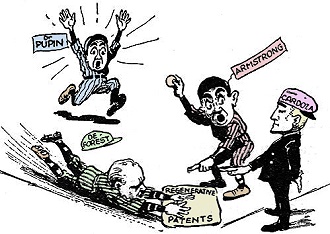"Final" Action in Radio Feed-Back Case
|
|
If you think controversial and otherwise inane decisions made by high-level courts is something new to this era of political high dudgeon, think again. This article in the January 1935 in Radio-Craft magazine reports a Supreme Court decision over who was the inventor of regeneration in radio circuits - Dr. Lee de Forest or Major Edwin H. Armstrong. Evidently in spite of much support by the opinions of notable experts in the field who claim Armstrong deserves credit, the Court found in favor of de Forest. The battle had been fought at many levels for the previous 18 years. Columbia University's Professor Michael I. Pupin wrote, "On several occasions after that I have had conversations with de Forest which convinced me that he did not know of or understand the production of radio frequencies by vacuum tubes." Major Armstrong eventually committed suicide over his distraught state over this and other issues. "Final" Action in Radio Feed-Back Case This is how one of our staff artists visualizes the arguments in and out of court concerning the "regeneration patents." It will be remembered (Radio-Craft, August 1934, page 70) that the United States Supreme Court, presided over by Judge Cardoza decided that Lee de Forest was the inventor, and held that de Forest had heard a "clear heterodyne" before Edwin H. Armstrong, then a student at Columbia University, had struck upon the same phenomenon. Major Armstrong recently petitioned for a rehearing of the case with the object of reversing the Supreme Court ruling, and the latest decision of the court is a denial of that application. In addition to the legal actions which have taken place, a heated argument has been progressing in the New York Times, between Professor Pupin and Dr. de Forest concerning the opinions of the former who has rallied to the support of his colleague, Armstrong. This argument has become heated to the point where many bitter words are being said by both parties involved. In the latest epistle by Prof. Pupin, over half a column in the Times, is devoted to a "tabulation" of the names of famous scientists and radio engineers who take sides with Armstrong. So famous an authority as Dr. Irving Langmuir is quoted as having made the following statement: "Ever since 1913 when I first learned of your (Armstrong's) pioneering work in this field, I have known the great value of your contributions. On several occasions after that I have had conversations with de Forest which convinced me that he did not know of or understand the production of radio frequencies by vacuum tubes. I have therefore been amazed at the fact that the highest court has previously upheld the de Forest patent." Professor Pupin sums up his letter with the following remarks: "The court holds Dr. de Forest to be the inventor; the scientific world is a unit holding Armstrong to be the inventor." - and -" ... I have never heard of any scientific opinion of recognized weight supporting the de Forest claims." "Dr. Langmuir, a recent Nobel Prize man, was one of the claimants of the same invention which was under litigation between Armstrong and de Forest for eighteen years. "Third, the famous radio engineer, Mr. Round of England, one of Marconi's right-hand men, also sent hearty approval of the decision of the Court of Appeals of the Second Circuit, (which gave the decision to Armstrong - Ed.) Both these letters appeared in full in the Columbia Alumni News of September 29, 1933. "Fourth, the very significant fact that Cyril Elwell, who was the chief engineer of the Federal Telegraph Company, the company employing de Forest at the time he claims to have made the invention, supported Armstrong, as did Professor Leonard Fuller, now head of the Electrical Engineering Department at the University of California." It seems that while Dr. de Forest has the upper hand as far as legal proceedings are concerned, he must now vindicate himself in the eyes of Professor Pupin and his supporters. And so the Feed-back case seems no nearer to an end, in one sense, than it has been for the past ten or twelve years.
Posted November 15, 2023 |
|

